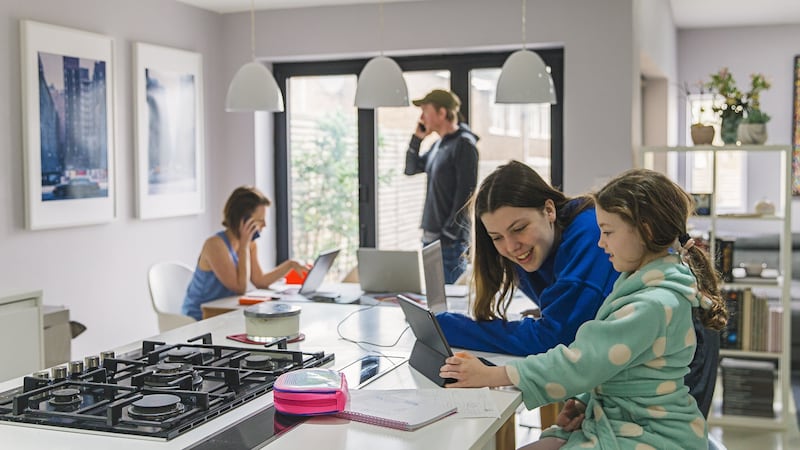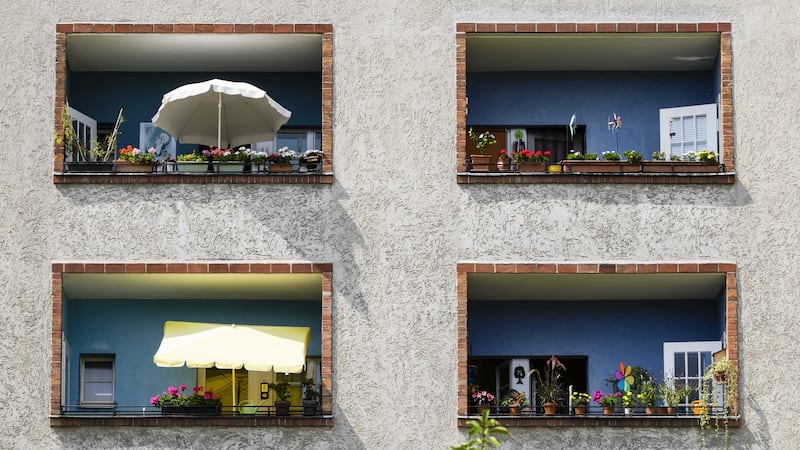The past weeks have taught us more about our homes than we possibly ever wanted to learn. We may have discovered we love the way the light falls on a particular wall at around 3pm, or that we’re not so crazy about our bold colour choices in the livingroom. Many are learning that their photogenic and previously beloved open-plan cooking, eating and living rooms are a nightmare when you’re all together 24/7. Virginia Woolf was wise when she wrote that everyone needs “a room of one’s own”.
For families, schooling and working together has changed how we view the places we call home, while those living solo will have found out what people with disabilities always knew, as they come to see their own four walls anew, over and over again. Will Covid-19 change how we build? And if it does, what might things look like in the future?
As Nathalie Weadick, director of the Irish Architecture Foundation, puts it, "designed space, internal or external, has never been tested like this before. This emergency shows architecture's great central responsibility – the potential to shape lives for the better."
Limiting your outdoor life to a 2km radius underlines just how mean is the width of many urban pavements, and just how inadequate are so many of the city's green spaces
So what do those who design our houses think about the changes that may come? And what might it all mean for the future of architecture in general?
Architect Emmett Scanlon says that it has never been more important for architects to find a collective shared voice, to advocate, criticise and shape how we move forward.
“Architecture is for the public good,” he says. “It has a role to play in civic society, as health does. This is our greatest challenge: to rip architecture from the body of development, and build a new skeleton around it, to make a healthy, human, lively body, in which all things work together for longer.”

Interestingly many of the architects I asked about these issues initially zeroed in on the importance of shared space and public space. Perhaps there’s something about being housebound that makes you think of the outside world first. Or maybe limiting your outdoor life to a 2km radius underlines just how mean is the width of many urban pavements, and just how inadequate are so many of the city’s green spaces. Or equally it could mean that, as human beings, we are both gregarious and private. Quite simply, to truly thrive, we need the best of both.
Ciarán Ferrie, Ciarán Ferrie Architects
"There was a recent report of a man in Toulouse who managed to run a marathon by running up and down his apartment balcony 6,000 times. It would be impossible to break into a run on most apartment balconies here. It is difficult to imagine how an apartment designed to Ireland's minimum standards, to accommodate the bare essentials of a home – sleeping, washing and eating – could accommodate the needs of a couple working from home, with a child being home-schooled. Or how they could provide the necessary breathing space for an older couple who can no longer leave their home.
“The housing stock that was built in the 1940s, 50s and 60s, by contrast, has proved much more robust and adaptable to different ways of living. There is some hope that amidst this crisis people are becoming more open to new ways of thinking, different lifestyles, different working arrangements – including ones that we can’t yet foresee. This will mean a move away from the idea that certain types of housing are for a particular demographic, at a particular stage in life, for example; that apartments are for young professionals who will eventually move onto a ‘real house’, and this means a move away from micro apartments.
"It also brings into question whether the co-living model can ever be sustainable – not just because of the size of the living units, but because of the implications for sharing living space with strangers in a post-pandemic world."
cfarchitects.ie

Alice Casey, Taka Architects
"Obviously, everyone's relationship to their home is under intense and unavoidable scrutiny at the moment. I'm hoping that this situation might make ministers and policy-makers rethink their fairly recent reduction in space and quality standards for apartment design especially."
taka.ie
Niall McCullough and Valerie Mulvin, McCullough Mulvin
"The situation challenges us; it challenges the idea that history is over, it challenges ideas of continual growth. I don't have a huge belief in millenarian concepts of change, that all will be adjusted after this. I think most things will go back to an approximation of where they were, but what might stay is a quality of doubt.
“Confinement will undoubtedly sharpen views on space and functionality, how things work, how soundproof walls are, how poor planning and layout inhibit your life. Being asked to maintain distances makes you think of closeness. People will also become very conscious about the extent of private open space available to them in houses and apartments, and make closer judgements about how far public parks and open spaces are from them.
'The current scenario we find ourselves in argues against open-plan apartment design'
"To take an alternative viewpoint, it could also lead people to think harder about leaving crowded cities and going to live in a broadband-friendly countryside; if that project works, it has the capacity to assist in repopulating small towns and villages, but there would have to be a complete revolution in the way those places are thought about. It could also help with one-off houses in the countryside – not in building even more bungalows, but in the restoration of some of the many thousands of abandoned houses behind every second hedge."
mccullougmulvin.com
Jennifer O'Donnell and Jonathan Janssens, Plattenbaustudio
"I guess we're all resisting the idea of designing for a primarily interior world – the thought is terrifying. But, with that said, I would use the old Berliner 'altbau' apartments as an example from the past of good apartment design. Where possible, all rooms were of more or less equal size within an apartment. Sounds wasteful, but it means flexibility, in that one person might choose to designate a room as their bedroom, another might make it their kitchen, a studio or an office.
“The contrast to modern housing of course is that, for example, a box room or kid’s bedroom, planned to the size of a standard bed plus free space beside it, is limited in how its function might change over time. The Berlin altbau apartments typically have rooms of 20-30sq m, allowing practically endless combinations of how they might be used.
"The current scenario we find ourselves in also argues against open-plan apartment design. This model was always unacceptable without some form of modulation between the different functions, but that's becoming even clearer now. It's important to consider how to mediate the proximity a person has to different spaces in their home, to ensure a person can retreat to a living space (not a bedroom space) without being in full show of the rest of their family, to be able to sit on the sofa and not see the dirty dishes in the kitchen. These sound like little things, but they make a difference to people's psychological health."
plattenbaustudio.com

Peter Carroll, A2 Architects, with Michael Pike and Grace Keeley of GKMP
"We will need to build better, safer and more lovable places to live and work. A number of commentators have been arguing that density and crowding are the same – they are not. One can have density without crowding; likewise, one can have crowding without density. We will need to have a conversation on doing density better. We have been designing cities and suburbs to give the car every advantage over public transport, walking and cycling.
“Our housing stock will need to make greater allowances for adaptability at home. Working from the kitchen table is fine in the short term, but juggling the demands of a full house in an already confined interior with work and study is testing most households, especially at a time when mental health effects of mass isolation and anxiety are still unmeasured. When your daily commute shrinks to the distance between your bed and your kitchen table, the world can seem pretty small. Amongst us all, illness, anxiety and disrupted routines are focusing attention on the things that matter most in life, whether this is a loved one, a source of income, or even a sunny spot by a window.
We are going to see a renewed delight in community, in neighbours. And yes, working sometimes from home will help all this, and stop housing from being dormitories
"In order to recover from this enormous economic shock we will need to embark on a massive public works building programme. The current relaxation of the EU rules about government borrowing and the prospect of extremely low interest rates for the foreseeable future makes this the ideal time to invest in the construction of the housing and infrastructure that we so desperately need."
a2.ie; gkmp.ie
Dominic Stevens, JFOC Architects
"I hope this lets us as a society realise (a) the value of the collective city, of public space, of gathering together to see a play, listen to a band, or go to a sporting spectacle; and (b) the value of quiet introspection, of local walks and non-consumption.
“Having lived for years in Leitrim, I now live in an apartment building in Stoneybatter. I’m fascinated by how I only meet my neighbours if I slow down and sit in the shared garden that forms part of the entrance sequence. This is an essential component of housing design, this careful ecology of shared space.
"I don't believe we are going to see a society that stays two metres from one another. We are going to see a renewed delight in community, in neighbours. And yes, working sometimes from home will help all this, and stop housing from being dormitories."
jfocarchitects.com



















